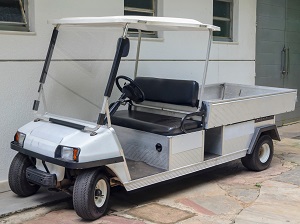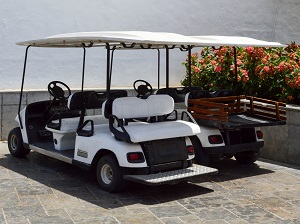Electric or gasoline powered golf carts used for on-the-job transport outside of a golf course may be referred to by different names depending on the type of vehicle used and the preference of the organization, including:
- Golf Carts
- Golf Cars (from ANSI Standard Z130.1)
- Golf Buggies
- Powered Carts
- Low Speed Vehicles (LSV)
- Utility Vehicles
If you intend to drive a golf cart on any public roads, which may be necessary if the streets are adjacent to or connect company properties or job sites, it is important to clearly understand local area and state laws and additional licensing may be required.

Before driving any golf cart, the operator should conduct a pre-trip safety inspection to check the following:
- Fluids – perform a quick check under the vehicle to ensure nothing is leaking
- Tires – check all tires for proper air pressure
- Controls – the brakes, accelerator and steering should all respond properly and move freely
- Lights and Horn – make sure they work properly
- Seatbelts – should be in good working condition
If anything is missing, broken, damaged or otherwise not working properly, do not use the golf cart. Immediately take action to remove the golf cart from service following your organization’s procedures to do so.

To stay safe, golf cart operators must understand the limitations of golf carts and how they differ from motor vehicles and forklifts.
OSHA General Duty Clause 5(a)(1) Each employer shall furnish to each of his employees employment and a place of employment which are free from recognized hazards that are causing or are likely to cause death or serious physical harm to his employees.
A golf cart may seem like it’s slow and harmless, but serious injuries can occur because of unsafe golf cart use. Every year OSHA investigates injuries, and sometimes fatalities, that occur because of incidents involving a golf cart. Golf carts moving at speeds as low as 11 miles per hour can easily eject a passenger during a turn.
OSHA Standard 1926.21(b)(2) The employer shall instruct each employee in the recognition and avoidance of unsafe conditions and the regulations applicable to his work environment to control or eliminate any hazards or other exposure to illness or injury.
Most injuries that occur because of a golf cart happen when:
- passengers are ejected
- there is a rollover incident
- a collision occurs with another vehicle, a stationary object or a pedestrian
- passengers are getting into or out of a moving golf cart
- the driver loses control

Do not put the golf cart in motion until all passengers are safely seated. Stunt driving and horseplay are not permitted. Never operate a golf cart while under the influence of drugs, alcohol, or any medication or other substance that may cause fatigue or affect alertness. Report accidents and damage to a supervisor as soon as possible, regardless of whether property damage or personal injury occurred.
Golf cart operators have a responsibility to drive safely and follow all safety precautions. Only drive on designated paths and roadways. Operate the golf cart from the driver’s side only. Do not drive the golf cart with your left foot hanging outside of the vehicle. Before carefully backing up, turn around and look behind the golf cart. Golf cart drivers should always drive courteously and yield the right-of-way to pedestrians.
Avoid distractions while operating a golf cart. Be safe and attentive. Do not use a cell phone while operating a golf cart. Do not drive with an open beverage container or while wearing headphones.
When driving a golf cart, avoid excessive speed, sudden starts or stops, and fast turns. Only tow loads if the golf cart is designed for towing. Drive straight up and down slopes to reduce the risk of passenger ejections or rollover.

The golf cart operator should always slow down when:
- on a slope
- approaching turns
- at corners or intersections
- while passing through doorways
- in bad weather or poor visibility conditions
- when pedestrians are in the area
As the operators have specific safety guidelines they must follow when driving a golf cart, passengers also play a vital role in their own safety. There may be times when it is up to the golf cart operator to enforce these rules.
Everyone riding in the golf cart must remain seated while the vehicle is in motion, or about to start moving. Keep all body parts including hands, legs, and feet inside the golf cart while it is in motion. If seatbelts are available, they should be worn. The number of passengers should never exceed the number of seats available. No one is allowed to ride while standing in the golf cart or on the back platform of the vehicle.
When parking, never leave the keys in an unattended golf cart and make sure the parking brake is set.
Do not park the golf cart in a way that blocks or limits access to:
- emergency equipment, like fire extinguishers
- fire lanes
- building entrances or exits
- sidewalks or common walkways
- accessibility options, like ramps


.jpeg)
